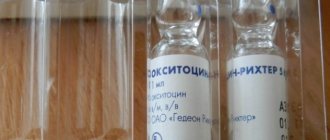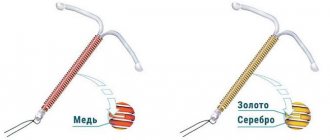Bleeding after cesarean section is normal. Blood loss is slightly more abundant than after a natural birth. And the nature of bleeding in the postpartum period can be different. Such changes allow the doctor to judge the health status of the mother in labor. Various complications often arise, some of them quite dangerous. To prevent their development, preventive measures should be followed.
Features of discharge after cesarean section and their difference from traditional ones
The uterus recovers after a cesarean section in about one and a half to two months. During this period, patients need to be as sensitive as possible to their well-being in order to notice the slightest changes in their condition. The nature of bleeding after cesarean section differs from discharge after natural delivery. What is the difference?
- In the first postpartum week, lochia, in addition to blood, contains a lot of additional impurities such as mucus, dead epithelial cells, plasma, etc. After normal childbirth, mucus is not observed in the mass discharged from the vagina.
- Caesarean sections are characterized by the presence of a larger area of wound damage, so the likelihood of inflammatory or infectious complications increases significantly. Therefore, postoperative rehabilitation requires mandatory compliance with all hygiene requirements several times a day.
- During the first few days of the postoperative period, the normal shade of the discharge is scarlet or bright red; the bleeding appears to have a much richer shade than after natural delivery.
- Healing and contraction of the uterus after surgery takes a longer time, and therefore lochia is released for a week or two longer.
It is this kind of discharge that is considered normal during birth by cesarean section.
How the nature of lochia changes during the recovery period
If no complications arise, then the following changes occur in the nature of the discharge:
- During the first 5-7 days, discharge after a cesarean section consists of blood with clots and mucus. The volume of discharge for all these days is approximately 500 ml. Discharge increases with walking, straining the abdomen, and breastfeeding.
- By the beginning of 4-5 weeks, the volume of lochia decreases, they become scanty and red-brown. They have a faint musty odor.
- At 6-8 weeks they lighten, become white, slimy, the same as before pregnancy.
Normal lochia does not have an unpleasant odor. In the first days after surgery, a woman may experience a slight nagging pain in the uterine area.
Characteristics of discharge
During the entire rehabilitation, lochia will gradually change its characteristics. At first, bloody clots will predominate in the discharge masses, since there is a large surgical wound in the uterus. But over time, it will begin to heal, the amount of blood will decrease and will be partially replaced by mucous discharge, dead epithelial cells and other postpartum waste.
The postpartum woman should be sure to monitor changes in the nature of the discharge in order to promptly detect pathological signs, if any. If in the first postoperative days blood in the discharge is considered normal, then after more than a week a similar character of lochia is a sign of pathology.
It is also normal when the discharged mass contains clots, which are cells of the placenta and dead epithelium. After about a week, the thickened impurities in the lochia will disappear, and the consistency of the discharge will become more liquid. If the discharge comes with mucous impurities, then this is a normal sign, indicating the processes of intrauterine cleansing of the body from fetal vital activity.
If spouses do not maintain proper sexual rest and begin to have sex ahead of time, then the lochia may acquire a pinkish tint. This is due to damage to healing tissues. After about 1.5 months, vaginal bleeding after cesarean section takes on the appearance of traditional menstrual brown smears. At this stage, already coagulated blood is released, which is why the color of the lochia becomes less bright.
A watery, almost transparent discharge is considered a dangerous sign. This can cause fluid to be released from the lymphatic or blood vessels, which indicates a blood supply disorder. If, after a cesarean section, a watery and unpleasant-smelling mass is released, this may indicate vaginal dysbiosis or gardnerellosis.
No less dangerous are purulent masses, indicating inflammatory lesions of the uterine endometrial layer. Externally, such discharge is distinguished by a greenish or yellowish tint, has a sharp disgusting odor, and is accompanied by hyperthermia and painful sensations in the perineum and uterus.
Quantity
A young mother also needs to pay attention to how much lochia comes out of her in order to judge how the body’s recovery is proceeding. If after a cesarean section there is little discharge, especially in the very first days, this may be an alarming signal that the tubes, uterine ducts are clogged, a blood clot has formed, etc.
The opposite situation is no less dangerous: profuse lochia that does not stop for too long is an alarming signal about the impossibility of full restoration of the uterus after surgery. In both cases, you need to undergo a special examination and find out what is the reason for such deviations.
Any woman wants postpartum lochia to end as soon as possible and nothing to overshadow happy motherhood. However, there is no need to be too hostile towards them. It is they that can serve as that alarming and sometimes the only signal that not everything is in order with the restoration of the body and some measures need to be taken to help it. You should especially be wary of discharge after a cesarean section with an odor and an unrealistically bright hue. This almost always ends with a course of antibiotic treatment, which is highly undesirable during lactation, or another surgical intervention.
After a cesarean section, vaginal discharge is normal for a woman. This is due to the fact that the microflora and damaged mucous membrane must be restored. The duration of discharge should last from one and a half to two months. However, the nature of the discharge is constantly changing due to the restoration processes in the woman’s genital organs.
During the first week, the discharge is red with a musty smell. They are associated with the contractile activity of the uterus, during which the remains of the placenta and blood are released from it. The amount of discharge per day should not exceed 100 ml . Increased blood flow is facilitated by walking, physical activity, and breastfeeding. This is due to increased contractility of the uterus. Such discharge resembles heavy periods after a cesarean section.
After a week, the nature of the discharge changes, it becomes darker and browner. Their number decreases sharply due to the fact that the uterus has taken its original position and contractions do not occur. However, they last much longer and end by the fourth week after cesarean section.
A month after the caesarean section, the discharge becomes spotty and lasts for about a week. Then the microflora of the internal genital organs is completely restored, and the woman may notice a clear discharge, which is observed for no more than two weeks. After two months from the moment of cesarean section, all discharge should stop.
The amount and duration of discharge in a healthy woman is influenced by a number of factors:
- The physical condition of the woman. If the mother regularly exercises, vaginal discharge will stop much faster.
- The woman's condition after the operation. Increased activity and constant walking help reduce the duration of discharge.
- Breastfeeding a baby. This act promotes the release of hormones that increase uterine contractions.
- Frequency of urination. Normal uterine contraction is possible only if the bladder is not full. If a woman rarely goes to the toilet and holds back her urine, the duration of the discharge increases.
How long the discharge lasts after a cesarean section depends only on the woman herself and her behavior after the operation.
Yellow discharge after cesarean section
Some women who have had a caesarean section may experience yellow vaginal discharge for two months. They are associated with weak contractility of the uterus, but this condition is not pathological. Also, yellow discharge may appear when the red or brown discharge after a cesarean section ends. In some cases, yellow discharge indicates diseases that arose as a complication of the operation.
The main cause is endometritis (inflammation of the inner layer of the uterus). It occurs as a focal lesion or spread to the entire mucous layer of the uterus. The disease occurs acutely and is accompanied by endometritis characteristic symptoms:
- Pain in the lower abdomen and perineum;
- Discharge after cesarean section with a putrid odor;
- Increased body temperature;
- Deterioration of general condition.
Also, during a cesarean section, the infection could penetrate into the large gland of the vestibule of the vagina. Yellow discharge is observed if light pressure is applied to the excretory duct of the gland. Discharge often appears while walking or after taking a shower. In such situations, the woman unknowingly puts pressure on the excretory duct, as a result, a yellow mark remains on the underwear. A distinctive feature of the disease is a slight deterioration in general condition (weakness, drowsiness, fatigue).
Upon examination, the gynecologist discovers an increase in the size of the uterus, soft consistency and pain on palpation, and an open canal of the cervix. Endometritis is caused by infection during delivery.
Brown discharge after cesarean section
Normally, brown discharge may accompany the postpartum period and continue during the first month after a cesarean section. If the postoperative period is uncomplicated, the amount of discharge decreases over time. If by the end of the month the amount of blood released has not decreased, this condition is considered a pathology and the woman is suspected of having intrauterine bleeding.
The cause of bleeding after cesarean section is uterine suture dehiscence. In addition to the duration of the brown discharge, bleeding can be suspected based on the woman’s general condition:
- Pale skin;
- Lethargy, fatigue, drowsiness;
- Heaviness while walking, especially on steps;
- Increased heart rate, decreased blood pressure, increased respiratory rate.
If the doctor notices a woman’s disturbed condition, he prescribes a general blood test, which confirms the presence of bleeding (decrease in the number of red blood cells, hemoglobin). Ultrasound also helps diagnose the complication, which determines the location of the suture and its condition. Seam divergence occurs for a number of reasons:
- Increased contractile activity of the uterus, which is caused by constant breastfeeding or the administration of medications;
- Physical activity of a woman in the first days after a cesarean section, lifting weights;
- Failure of surgeons to comply with surgical tactics or use of low-quality suture material.
Tactics for dealing with discharge after caesarean section
After a cesarean section, a woman needs to monitor her discharge. Doctors do not recommend using regular pads, as they make it difficult to monitor the amount of blood released, and they are not suitable due to increased bleeding. Women are prohibited from using tampons in the postoperative period, as with them bleeding will continue much longer.
A woman must regularly observe the rules of personal hygiene:
- Wash yourself at least twice a day;
- The frequency of shower visits may increase depending on the number of visits to the toilet; it is imperative to wash yourself after defecation;
- For washing, use warm water to which herbal decoctions (chamomile, calendula) are added;
- Bathing in the bath is not recommended to prevent inflammatory diseases and reduce the duration and amount of bleeding;
- Do not use shower gels or soaps, as they are irritating and cause allergies.
It is also recommended that a woman not be sexually active for two months to avoid infection in the uterus.
There is no need to be afraid of discharge after a caesarean section, as this is a normal condition. However, it is necessary to monitor them, their nature and quantity, and in case of an unpleasant odor or deterioration of the general condition, immediately contact a gynecologist. A woman’s discharge after a cesarean section, how long it lasts, also depends on her compliance with all the obstetrician’s recommendations.
Important! If the suture is festering after surgery, look at this material!
Menstruation after cesarean section
Often, a woman may confuse menstruation with abnormal discharge after a cesarean section.
This is due to the fact that there is no clear time frame for the resumption of the menstrual cycle after surgical delivery. This process is purely individual and depends on the reaction of the woman’s body to childbirth, as well as on external factors:
- Breastfeeding or feeding the baby with artificial formula. When breastfeeding a child for a year, menstruation may be completely absent and return only after lactation stops.
- Nutrition of a woman during pregnancy and after it. Good nutrition will help speed up the process of restoring the menstrual cycle.
- Emotional state, the presence of stressful situations in the postpartum period. Emotional stress contributes to the formation of hormones that constrict blood vessels and prevent the occurrence of menstruation.
- Complications that occurred during pregnancy or after a cesarean section. The resumption of the cycle is also affected by general diseases that were present before pregnancy. All pathologies delay the onset of menstruation.
- The lifestyle that the woman led throughout her life and after the operation. Bad habits lead to late recovery of the cycle, while physical activity contributes to the early normalization of menstruation.
It is necessary to worry about menstruation if, after stopping breastfeeding, menstruation does not occur within three months, as well as if the cycle has not been restored within six months after the first menstruation. It is recommended for a woman to consult a doctor if there is an unpleasant smell of discharge or spotting bruises before and after menstruation.
Recommendations
A woman after a cesarean section is recommended to do everything to ensure that the menstrual cycle is restored as soon as possible and that the discharge does not last long. It is necessary to prevent the development of inflammatory diseases of the reproductive system, which consists of maintaining personal hygiene and abstaining from sexual intercourse.
All women following a caesarean section are advised to breastfeed as this is a natural process and has a positive effect on hormonal balance.
If deviations from the norm appear in the discharge, you should immediately contact a gynecologist for advice.
bukovka_a
27-06-2006, 08:16
I had my second cesarean section. The discharge after the operation ended after three weeks. Now, at the baby’s two months, I suddenly began to stretch my lower back, as if during menstruation, and for several days now I have been discovering that there are literally two drops of pink-bloody discharge per day.:005: It doesn’t look like menstruation, since the discharge is too scanty, and we are and at full breastfeeding, which also reduces the likelihood of such early periods, although it does not exclude it. It’s clear that I need to get an ultrasound and see a doctor... For now, I want to ask: should I really start to be afraid? Has anyone had anything like this? What did the doctors say?
Caesarean section is an abdominal operation that is performed when spontaneous childbirth is not possible. Regardless of whether natural or surgical childbirth, after the birth of a child, the mother begins to discharge - lochia. Why do they appear, how long do they last and how to take care of yourself during this period?
Why is there discharge after a caesarean section?
During the operation, the surgeon cuts not only the abdomen, but also the uterus. Therefore, the opinion that women who give birth by cesarean section should not have discharge is erroneous. The first day after giving birth, the mother is in intensive care because she needs constant monitoring. Doctors monitor the condition of the uterus, because if contraction is insufficient, there is a risk of developing pathological bleeding. The cardiovascular system is also assessed using indicators on the monitor.
After abdominal surgery, the uterus is damaged and time is needed to restore its internal mucous membrane. The healing process is accompanied by postpartum discharge (lochia), consisting of mucus, blood and dead epithelium. During the healing process, the shade, structure and volume of the discharge changes. The same thing happens during natural childbirth, only the recovery period is faster.
Video - caesarean section. School of Doctor Komarovsky
Discharge after abdominal surgery
Postpartum discharge is a physiological phenomenon through which particles of the placenta and dead remnants of the endometrium are removed from the body.
- Vaginal discharge is most abundant in the first week and has a rich red color. They resemble regular periods, but in a much larger volume. Walking, breastfeeding, and changing body position increase blood flow. For the first five days after surgery, bleeding of about 500 ml is considered normal.
- Then the lochia darkens and acquires a brown tint. The appearance of clots is a normal phenomenon associated with the low mobility of the woman in labor. The discharge is characterized by a specific odor similar to iron.
- By the fourth week, the discharge becomes dark brown and its volume decreases significantly. They become scanty and smearing.
- By 2.5 months, the discharge becomes transparent and mucous. They do not cause any inconvenience and are odorless.
At what stage the discharge will change color, composition and volume depends on the individual characteristics of the woman who gave birth. But they should start with red, turn brown, and end with mucous and transparent discharge.
Active contraction of the uterus affects the intensity of discharge in the initial days after the birth of the child. During abdominal surgery, muscle fibers are damaged, which makes contraction much more difficult. To stimulate uterine contractions, it is recommended to lie on your stomach as often as possible, empty your bladder regularly, and put your baby to your breast on demand. Sucking milk increases uterine contractions, accompanied by painful sensations in the lower abdomen.
In the first 6–8 days, the discharge is especially strong; this period accounts for most of the fluid released. In the second week, the amount of discharge begins to decrease, and at the end of the month it decreases significantly. At week 5, lochia becomes spotting, and after a week it stops altogether.
Postpartum discharge can last up to 1.5 months, depending on the individual characteristics of the woman’s body, pregnancy and childbirth.
No doctor can tell you the exact numbers for the beginning and end of postpartum discharge. But there are average statistics that need to be compared to and if deviations are detected, immediately consult a doctor.
Pathological discharge
The reason for contacting a specialist may be: a sudden cessation of discharge just a few days after birth, the appearance of an unpleasant odor, a change in the composition of the discharge, or the appearance of itching. The reasons for certain changes are presented in the table.
Deviation Cause Change in the smell of discharge Endometritis A sharp increase in the amount of discharge Hypotonic bleeding An abrupt cessation of discharge Bend of the uterus Burning, cheesy discharge Candidiasis
Change in smell of discharge
An unpleasant, purulent, pungent odor indicates inflammatory processes on the inner surface of the uterus or, in other words, endometritis. The disease is accompanied by an increase in body temperature, increased pain in the lower abdomen, and a deterioration in the woman’s well-being.
A sharp increase in the volume of discharge
An increase in the number of lochia and their long-term non-reduction indicate the onset of late hypotonic bleeding. It is after abdominal surgery that this happens most often, since the uterus cannot contract normally due to the suture formed.
Abrupt cessation of discharge
The immediate end of postpartum lochia indicates a possible bending of the uterus. In this case, there is a disruption in the outflow of secretions from the uterus, leading to their stagnation. If not treated promptly, this leads to inflammation or endometritis.
Curdled discharge and itching
Unpleasant sensations in the vagina, itching, burning, changes in the structure of discharge indicate thrush. Its development may be associated with improper hygiene of the woman who gave birth or the use of antibiotics.
Hygiene after caesarean section
In the maternity hospital, you need to wash yourself several times a day with warm water and laundry soap. The first days you need to use diapers, on the third day you can use large pads. It is recommended to change them as they are filled, but at least once every three hours. For convenience, disposable panties are used. The use of tampons is unacceptable to avoid the proliferation of microbes. The suture is changed daily, and ice can be applied to increase uterine contractions. The condition of the seam must be monitored very carefully so that it cannot and does not bleed. Otherwise, a doctor's examination is necessary.
At home, regular washing should be continued until the discharge becomes colorless, approximately 8 weeks. It is prohibited to take a bath, douche, or have sexual intercourse until you receive permission from your gynecologist. It is possible to resume your previous life only after the final restoration of the uterus and the cessation of spotting.
Menstruation after cesarean section
After the birth of a child, the female body begins to produce the hormone prolactin, which blocks the development of follicles in the ovaries and stimulates milk production. When breastfeeding, menstruation usually occurs after 6–7 months; with active feeding, it can occur after a year. With artificial feeding, menstruation comes in 2–3 months. At first they are irregular, and then the cycle is restored.
Postpartum discharge lasts a different amount of time for each woman, but usually does not exceed 1.5 months. Following personal hygiene rules and regularly changing pads prevent infection. Feeding the baby on demand and lying on his stomach stimulate uterine contractions. Compliance with doctors' instructions will help you overcome the recovery period with ease.
It is important to closely monitor the discharge and if an unpleasant odor appears, a sharp increase or stops, consult a gynecologist for advice.
Discharge after a cesarean section appears the same as after a natural birth. A large number of women who are about to undergo such a delivery mistakenly believe that the entire recovery period consists of completely tightening the sutures on the abdomen and cleaning the uterine cavity and vagina. But that's not true! After all, during a caesarean section, an obstetrician-gynecologist helps the baby, as well as the placenta, to be born. But the doctor does not scrape the uterus to remove the endometrium. Since in itself this is a very traumatic procedure and quite pointless. This is because a woman’s body is physiologically designed to get rid of excess epithelium, which will subsequently interfere with the functioning of the reproductive system. The only thing a woman should know is the amount of normal discharge and the number of days it lasts (again, normal).
Duration of bleeding
Another exciting question for postpartum women after a cesarean section is: how long does the bleeding last? Knowing this is important in order to correctly assess the recovery process, whether it is proceeding normally or has already been delayed.
- Postpartum vaginal discharge during a cesarean section normally lasts about 7-9 weeks, so there is no need to worry about your health if lochia occurs after a two-month postoperative period.
- It is worth suspecting some deviations if the discharge lasts until 10 weeks, or ends too early (after 6 weeks). Such deviations may simply be a consequence of the individual organic characteristics of the postpartum woman, especially with a normal smell, shade and amount of discharge. For preventive purposes, such a problem should be discussed with a doctor.
- But if bleeding after a cesarean section stops after 5 weeks or lasts for more than 10 weeks, then you need to urgently consult a specialist. Both of these conditions are quite dangerous. When lochia ends prematurely, this indicates particles of dead endometrium remaining in the uterus, which can lead to purulent processes. If the discharge, on the contrary, exceeds the normal duration, then the cause may be an infection in the reproductive system or peritoneum or inflammation of the endometrial layer. Also considered a pathology are lochia that has ended, but for unknown reasons has returned again.
Knowing how many days lochia can normally last, it will be easier for a woman to assess her condition and determine the presence of abnormalities and pathologies.
How long does the recovery period last?
Discharge after a cesarean section appears on average within 6-8 weeks (with normal childbirth, the recovery period is approximately 1.5-2 weeks shorter). Deviations upward or downward may be associated with the individual characteristics of the organism.
If lochia stops earlier than after 5 weeks, this may indicate the occurrence of adhesions in the uterine cavity, bending of the cervix, and a violation of its contractility. In this case, there is a high probability of developing an infection in the endometrium and spreading through the bloodstream to other organs.
If the discharge after a cesarean section does not subside even after 8-10 weeks, this indicates that there is an advanced inflammatory process in the uterus.
What does the color of lochia mean?
The shading characteristics of the discharge can also indicate the presence of pathological postoperative abnormalities in the postpartum woman. Initially red, and then, by the middle to the end of the second week, brown and pale yellow shades of discharge are considered normal. Other shade options indicate any deviations or pathological complications.
If after a cesarean section a greenish substance comes out of the vagina, then this sign indicates purulent processes caused by inflammation or infections in the uterine cavity. Therefore, when such a sign appears, the postpartum woman must undergo a gynecological examination.
Pathology also includes discharge of bright yellow shades with admixtures of greenery and the smell of rot in the first week after cesarean section. They talk about the onset of endometritis. But if yellow discharge begins to appear in the third postpartum week, then we are talking about already advanced inflammation of the endometrium, which requires antibiotic therapy and even surgery.
If immediately after the operation a black substance is released, not accompanied by pain or a disgusting odor, then this is a completely normal phenomenon associated with hormonal changes in hematopoiesis. But if a similar sign appears several weeks after a cesarean section, then you need to consult a gynecologist.
Many patients are frightened by white discharge. If they are not accompanied by any abnormalities, then there is no need to panic - they are safe. But if they are accompanied by cheesy impurities, a sour smell, hyperemia of the genital mucous membranes and itchy sensations in the perineum, then it is necessary to take a vaginal smear or culture to determine the cause and causative agent of the infection.
Pathological lochia
Lochia can be normal and pathological. The following types of pathological discharge are noted:
- lochiometer;
- bleeding;
- endothermite;
- thrush.
Lochiometra is a sharp decrease or complete cessation of lochia, accompanied by pain in the uterine area, elevated body temperature and chills. Bleeding is characterized by a constant bright red color of the lochia 3-4 days after surgery or a repeated change in the color of the discharge, for example, it was red, then turned brown, and after a certain period - red again.
The term “endothermite” refers to inflammation of the uterus. This condition is characterized by yellow lochia with an unpleasant odor, as well as increased body temperature, pain in the uterus and an admixture of pus in the lochia, general weakness and fatigue.
Sometimes, due to the use of antibiotics after surgery, a woman in labor develops thrush. This condition is also characterized by itching in the external genitalia.
If, after the operation, the cesarean discharge ends earlier than a month and a half later or continues to occur for more than 10 weeks, but the number, color and smell of lochia are normal, then there is no need to sound the alarm. This phenomenon is most likely due to the characteristics of the woman’s body, although it would be useful to inform the doctor about this.
Black discharge immediately after childbirth, which is not accompanied by pain and an unpleasant odor, is provoked by hormonal changes in the postpartum period, so they should be taken as normal. But if such a phenomenon appears some time after surgery, you should immediately consult a doctor.
A young mother should consult a doctor as soon as possible if she discovers the following symptoms:
- abrupt cessation of lochia;
- long duration of discharge, accompanied by pain in the uterus and aching in the lower back;
- the appearance of an admixture of pus in the lochia, a putrid odor and a change in their color up to green;
- the appearance of cheesy discharge, accompanied by swelling in the genital area;
- copious with mucus.
In addition, you need to visit a doctor if lochia is accompanied by an unpleasant odor reminiscent of rotten fish. This condition may indicate the development of dysbiosis in the vagina.
How much blood does a woman lose?
In addition to how long the discharge is observed, an important indicator is the quantitative characteristics of lochia. A small amount of discharge in the first days of the postoperative period indicates the presence of some obstacle to the outflow of blood and characteristic waste from the uterus after cesarean section. The cause may be blood clots, pipe blockage, etc.
Excessive discharge that lasts for a long time is also dangerous. This happens when the uterus, for a number of reasons, is not able to fully recover. Therefore, deviations in the amount of discharge necessarily require diagnosis.
How to avoid postpartum complications
To speed up the removal of discharge after a caesarean section, a woman needs to periodically lie on her stomach to change the position of the uterus and improve its contraction. Emptying your bladder frequently and eliminating constipation prevents compression of the uterus.
It is necessary to massage the abdomen with gentle movements from time to time so that the discharge after a cesarean section goes away faster. It is useful to apply an ice compress to the abdomen below the navel several times a day for 5 minutes. This helps reduce bleeding and relieve tissue inflammation.
It is important to remember about careful hygienic care of the body, especially the genitals. After 7-10 days, when the incision has healed, you can take a warm shower (do not rub the seam with a washcloth). It is forbidden to wash in the bath for another 2 months.
48 hours after the operation, the woman is allowed to get up. Moderate physical activity helps prevent stagnation of discharge after cesarean section. For 2 months, a woman should not lift weights or play sports, especially exercises to strengthen the abdominals. It is not recommended to have sex during this period, so as not to introduce an infection into the uterus.
Complete restoration of the elasticity of the uterus and healing of the scar occurs after 2-3 years. It is important to take this into account when planning your next pregnancy.
Useful tips
To avoid postoperative complications, it is recommended to comply with certain conditions.
- Careful intimate hygiene should become a mandatory part of postoperative rehabilitation. To do this, you need to take a shower every day, and be sure to wash yourself after each urination and bowel movement. Immediately after a caesarean section, it is better to refuse pads and replace them with diapers for a couple of weeks. Later, when you start using sanitary pads, remember to change them after 4 hours. But tampons are strictly contraindicated.
- Care and monitoring of the condition of the seam is necessary, because if the regime is violated and hygiene requirements are not followed, it can fester.
- The uterus will have to shrink to its previous size, which will take some time. To speed up the process, it is useful to use a postpartum bandage belt, lie on your stomach more often, do not hesitate to go to the toilet if you want, you can apply cold to your stomach for 5 minutes 5 times a day. Massage of the abdomen, which is carried out with light and gentle movements, so as not to damage the suture, also has a beneficial effect on the contraction of the uterus. Sometimes patients are prescribed Oxytocin to improve contractile uterine activity.
- After a cesarean section, a woman in labor is prohibited from lifting weights; in the first postoperative week, she is prohibited from picking up a newborn. This limitation is due to possible seam divergence.
- For faster recovery, you should follow a diet that prevents the development of constipation and fecal stagnation. You also need to drink more fluids.
If the mother is breastfeeding, then menstruation will occur in about six months, but can come after a year, which depends on the activity of feeding. If the child is on artificial formula, then menstruation comes within a couple of months.
Every woman dreams that the postoperative discharge will stop sooner so that she can calmly take care of the baby. It’s worth being prepared in advance that lochia does not last for one day, but for 40-55 days. And there is no need to get angry because of this, because it is the discharge that acts as an indicator of normality or pathology during the recovery period after cesarean section. The best option would be to comply with hygiene requirements, sexual rest and monitor changes in discharge, then postoperative rehabilitation will take the shortest possible time.
When to see a doctor
A cause for concern should be unrelenting bleeding that continues beyond 8 days after birth. It is imperative to consult a doctor if the discharge after a cesarean section suddenly stops, although not even 5 weeks have passed. This means the occurrence of lochiometra (stagnation of lochia) due to premature closure of the cervix. The doctor prescribes antispasmodic drugs (no-spa, for example).
Particular attention should be paid to spotting that does not stop for more than 8 weeks, especially if it intensifies or develops an unpleasant odor or a greenish tint. In this case, the woman experiences signs of anemia (dizziness, pallor, weakness, low blood pressure, headache, nausea) or the presence of an inflammatory process (fever, abdominal pain, itching in the genitals).











